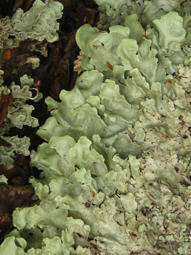Tourism with a handlens: lessening one's impact on the earth, learning to step softly, all the while appreciating the little things.
While in Punta Arenas, the Miniature Forest team was introduced to a diverse group of plant life. The area's wide variations in temperature, precipitation and altitude result in clear vegetation patterns throughout southern Chile. Along southwestern Chile, the mighty winds and mist create cold, wet moorland with bogs and dwarf shrubs, what we called "spongy habitats." Also, around the ice-fields, heavy rainfall in sheltered areas create environments conducive to mixed evergreen temperate rain forests consisting of high and low deciduous beeches, calafate bushes, and bryophytes.
According to Miniature Forests of Cape Horn, the forests of the Cape Horn Biosphere Reserve are some of the 37 most pristine areas remaining in the world. More than five percent of all species of mosses and liverworts known worldwide thrive in this secluded ecoregion.
The Miniature Forest team in the Tracing Darwin's Path UNT course explored the Omora Ethnobotanical Park, noticing yes, the larger trees and bushes, but paid close attention to the smaller details: a thick carpet covering the floor of the forests made up of lichens, mosses, and liverworts.
 Miniature forests are made up of two main types of species. The first group is non-vascular plants, which are divided into three categories: hornworts, liverworts and mosses. Because these non-vascular plants do not have veins to transport water, they live in humid environments and use diffusion to stay hydrated.
Miniature forests are made up of two main types of species. The first group is non-vascular plants, which are divided into three categories: hornworts, liverworts and mosses. Because these non-vascular plants do not have veins to transport water, they live in humid environments and use diffusion to stay hydrated.
The second group is lichens, which have a great variety of color and are actually not plants at all, according to Miniature Forests of Cape Horn. Instead, lichens are a combination of an alga and a fungus. They are further categorized into 3 main growth forms: crustose, foliose and fruticose.
 Aside from studying different forms of plant life, we applied some philosophy to our lessons. In one way or another, everything is interrelated. From Darwin's Fungus growing on a giant gall on a tree in Omora Park, to the Magellanic Woodpecker who inhabits that tree, to the beaver who eventually chops the tree down to build his home on Rio Robalo, to the fish who now has to swim around it. Learning to recognize and appreciate the relationship all living creatures share with each other is the first step in our path of conservation. It's beautiful, just like Professor Rozzi pointed out that frass and flowers together can be beautiful.
Aside from studying different forms of plant life, we applied some philosophy to our lessons. In one way or another, everything is interrelated. From Darwin's Fungus growing on a giant gall on a tree in Omora Park, to the Magellanic Woodpecker who inhabits that tree, to the beaver who eventually chops the tree down to build his home on Rio Robalo, to the fish who now has to swim around it. Learning to recognize and appreciate the relationship all living creatures share with each other is the first step in our path of conservation. It's beautiful, just like Professor Rozzi pointed out that frass and flowers together can be beautiful.
Contributor: Melissa Crowe, Journalism Undergraduate, University of North Texas

